We’re going to leave the land of Delosa and Deseret and Estacado for a moment and return to the world of Georgia and Missouri and West Virginia. Specifically, we’re going to look at the state of Georgia, its flag, and it’s relationship to the flags of the Confederacy.
Outside the South (and commonly inside it) people have some mistaken impressions about the flags of the Confederacy. The most commonly attributed flag was never actually the flag of the would-be nation:
The above is the Navy Battle Flag, the Southern Cross, the Battle Flag (or an elongated version of it), the Rebel Flag, or the Confederate (Navy) Jack. The recognizable emblem would be used on later flags, but what we consider “The Confederate Flag” has mostly persisted not because it was the official flag of the Confederacy, but rather because it is the most instantly recognizable. The official flag of the Confederacy was considerably more forgettable:
That would be the Stars & Bars, which was the official flag of the Confederacy until people began confusing it with the American flag on the battle field. So they replaced it with a white flag that was subsequently confused with a surrender flag and then, about the time they were actually surrendering, they put a red bar on it.

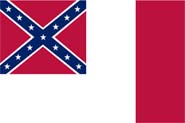
But enough about the Confederacy for a moment, let’s talk about Georgia. In 1956, Georgia replaced three horizontal bars on their flag with the Confederate emblem. It doesn’t take a whole lot to figure out why, in 1956, Georgia might be so motivated. Flash forward forty years and Georgians are stunned and outraged to discover that their black population doesn’t so much like their state flag including an emblem from an era that, to say the least, was not one they were particularly nostalgic for.

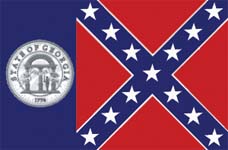
Eventually something was going to have to give, so at the turn of the century they designed what is considered by flag experts to be the most poorly designed flag in history. It allowed the Confederacy-boosters to keep the emblem somewhere on the flag, but kept it as small as possible and part of the old Georgia among a collection of mini-flags below the state emblem. Pro-Dixie whites were angry cause the Confederate emblem was so small. Blacks weren’t satisfied cause it was still there.
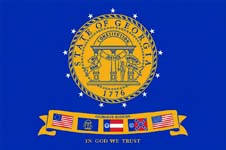
So they went back to the drawing board. It was seeming as though it was going to be impossible for the flag designers to come up with something that could please everybody. Then somebody got a clever idea.
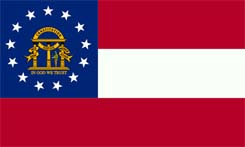
Blacks don’t mind it because it doesn’t have the emblem. Pro-Dixie types like it cause it’s their little inside joke. The design of one and the number of stars from the other. Utterly brilliant.
About the Author
3 Responses to Georgian Vexillology
Leave a Reply to Billy Bearden Cancel reply
please enter your email address on this page.

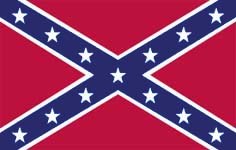

[…] /02/14/georgian-confederate-vexillology/”> {{The following is a reproduction of an old Hit Coffee post, reproduced because I have recently seen a few people get it wrong.}} Outside the South […]
Websites you should visit
[…]below you’ll find the link to some sites that we think you should visit[…]…
What is now commonly referred to as the “56 Flag” was created by a suggestion from Atlanta attorney John Sammons Bell, then-chairman of the State Democratic Party, attorney for the Association of County Commissioners of Georgia (ACCG), and later Judge on Georgia Court of Appeals. His desire was to “forever perpetuate the memory of the Confederate soldier who fought and died for his state.”,because as a young boy, he attended reunions of the old Confederate Veterans with his Grandfather, and learned the Battleflag was a soldiers flag.
On July 1st, 1956, Georgia Senate Bill 98 took effect. SB98 was signed into law on February 13th, 1956 by then-Governor Marvin Griffin, and it called for a new design to the Georgia State Flag.
Waynesboro State Senator and former Confederate Colonel Herman H.Perry designed the flag it replaced in 1879, based on the 1st Flag of the Confederacy, AKA Stars and Bars. Similar to our current flag, it had 2 red stripes and 1 white stripe, and a field of blue down the left side, which was a Government flag.
By 1955 however, people like Representative Denmark Groover argued at the time that the old flag never had enough meaning for him when he was a boy and that the new flag “would replace those meaningless stripes with something that has deep meaning in the hearts of all true Southerners”
Others like Senator Jefferson Davis of Cartersville also argued that the state should be entitled to adopt the new flag, because
“Georgia suffered more than any other state in the
Civil War and endured a scorched earth policy from
the mountains of Tennessee to the sea.â€
SB98 was discussed and passed with little fanfare, and became law on July 1st, 1956.
At the time, the only group that opposed the change was the UDC
It is a fact that under the 1879 Perry version flag, Jim Crow, lynching, segregation, and blatant discrimination were widely practiced and flourished in Georgia, as well as across America, but it is also fact that Georgia’s greatest gains in Civil Rights came under the “56 Flag”.
Under the 1956 Bell version flag, Georgia’s schools were fully integrated, Black citizens were no longer lynched, they began enjoying full civil and equal rights in business, political, and social settings. Georgia gained 3 professional sports teams – Falcons, Braves, and Flames – hosted 2 Super bowls, held the 1996 Olympics, and set the pace for the New South.
In 1958, the United States Congress passed laws granting the same rights and recognition enjoyed by Union Veterans to men who served in the Confederate States Army and Navy. To this day Confederate Veterans are United States Veterans.
Public Law 85-425 adopted May 23, 1958 as H.R. 358
AN ACT
To increase the monthly rates of pension payable to widows and former widows of deceased veterans of the Spanish-American War, Civil War, Indian War, and Mexican War, and provide pensions to widows of veterans who served in the military or naval forces of the Confederate States of America during the Civil War…
CONFEDERATE FORCES VETERANS
Sec. 410. The Administrator shall pay to each person who served in the military or naval forces of the Confederate States of America during the Civil War a monthly pension in the same amounts and subject to the same conditions as would have been applicable to such… if such forces had been service in the military or naval service of the United States.
Sec. 2. This act shall be effective from the first day of the second calendar month following its enactment.
Unfortunately, the 1956 Bell version flag had its enemies. Attempts at claiming the “56 flag” was changed to fight integration years after the Brown vs. Board Topeka Kansas decision helped begin the BIG LIE that remains to this day. Although the historical facts are out there that plainly refutes this, truth means little for those with anti Confederate agendas.
Concerning those who claim that the flag was “… designed as a last desperate grasp of defiance against integration.” Judge John Sammons Bell said,
“Absolutely nothing could be further from the truth … every bit of it is untrue.” He further stated, “Anybody who says anything to the contrary is wrong or perpetuating a willful lie.”
Also during 1956, several newspaper accounts of the proposed change in the GEORGIA FLAG were published. In none of the articles was there any hint that the flag change was for any reason other than that stated by the gentlemen who proposed the change.
Former Governor Ernest Vandiver said
“I can assure you that there was no discussion of segregation or of the U.S. Supreme Court. All that was discussed was the coming centennial of the Civil War and this flag was meant to be a memorial to the bravery, fortitude and courage of the men who fought and died on the battlefield for the Confederacy. More Americans died in that war than any other war in the history of America, before or since.”
In April 1992, the Atlanta Journal Constitution conducted a poll of 43,000 people, and their results were that 75% of citizens wished the “56 Flag” remain as is.
In a May 29th, 1992 article from the New York Times relating to former Georgia Governer Zell Miller’s failed attempt to change the flag, House Speaker Thomas Murphy from rural Haralson County said he had always promised “my folks” that he would not vote to change the flag. “I personally don’t see anything wrong with the flag we have,” Mr. Murphy said.
On July 5th, 1992, the Atlanta Journal Constitution released the results of their own investigation into the flag change of 1956:
“There is little written record of the 1956 Legislature and no audio record. News stories about the change were few. In none of our research did we find any record of a stated connection between changing the flag and opposition to desegregation rulings.”
On March 9, 1993, Denmark Groover took to the floor of the Georgia House to challenge then Gov. Miller’s proposal to change the 1956 flag. He admitted the obvious that segregation was a heated topic in 1956 and added,
“But those who now say that the legislature was obsessed with the matter of segregation to the exclusion of all other matters know not of what they speak…â€
[Groover’s March 9, 1993 remarks to the GA House are attached as Exhibit A to his 1994 deposition for the James Andrew Coleman lawsuit ]
Denmark Groover listed numerous appropriations made to fund historical markers and the Stone Mountain memorial in preparation for the tourism expected to accompany the 1961 Centennial Observances for the War Between the States:
· 1952 — HR 250-9286 (pp 1250,1331,1689,1815,1828) To Propose and urge the creation of a Confederate Memorial Park at Stone Mountain. Adopted 11Feb.1952
· 1953 — HB 160 (pp 12,131,134,171,374,381) To provide pensions for widows of Confederate Veterans Adopted 4 FEB. 1953
· 1953 — SR 65 (pp 1251,1260,1481,1491,1689) The Confederate Veterans’ Home property was given to the Georgia military department Adopted 1Dec.1953
· 1955 — HR 35 (pp114,134,759) A resolution urging the Governor to purchase Stone Mountain because, “the incomplete and unsightly condition of the Stone Mountain Memorial has long weighed upon the pride and civic conscience of all Georgians.” and the acquisition of Stone Mountain by the State would insure, “a lasting Memorial.” Adopted 18Jan.1955
· 1955 — HR 48 (pp155,200) Recommended the placing of a bust of General “Stonewall” Jackson in the Hall of Fame in New York City. Project was begun by the UDC and had the, “whole hearted endorsement,” by the State. Adopted 20Jan.1955
· 1955 — HR 145 (pp513,680,690,759) A resolution designating December 9th of each year as “Uncle Remus Day” Adopted 15Feb.1955
· 1955 — HR 195 (p800) A resolution honoring ‘Miss Anne Collins as, “Miss Deep South of 1954” Adopted 16Feb. 1955
· 1955 — HB 14 (pp32,37,51,81,82) A bill to establish the Georgia State War Veterans’ Home Adopted 7June1955
· 1955 — HR 22 (p90) “A resolution naming the new bridge across the Wilmington river “Memorial Bridge” in honor of deceased veterans.” Adopted 17June1955
· 1956 — SR 30 (pp 449,468,1135,1140,1378) a resolution creating the “All-south Centennial Committee of Georgia” Adopted 17Feb.1956
· 1956 — SR 48 (pp1068,1174) A resolution to preserve the Confederate Flags at the Capitol. Adopted 15Feb1956
· 1956 — HB 188 (pp 236,306,309,431) A bill to abolish the State Division of Confederate Pensions and Records. It was amended to put all records with reference to, “the glorious men of the Confederacy,” under control of the Department of Archival History. Adopted 26Jan.1956
· 1956 — HB 241 (pp 297,581,587) A bill to dispose of the Confederate Soldiers’ Home and to provide for the care of widows now living there. Adopted 2Feb.1956
· 1956 — SB 98 (pp 598,602,710,719,856) This is the bill that created the wonderful 1956 State Flag. Adopted9Feb.1956
· 1957 — HR 217 (p1027) A resolution to commend the Confederate Veterans’ Sons (SCV) for their efforts to preserve our glorious heritage. Adopted 20Feb.1957
· 1957 — HB 610 (pp 876,1036) A bill to increase the amount of pension given to widows of Confederate Veterans Adopted 19Feb.1957
· 1957 — HR 234 (pp1100,1179) A resolution to commend the formation of the Stone Mountain Confederate Memorial Association and encourage them (it) to finish the monument. Adopted 22Feb.1957
Numerous State funded Historical Markers were placed around Georgia in the following years:
1953-40, 1954-249, 1955-380, 1956-125, 1957-341, 1958-285, 1959-238, 1960-42, 1961-14, 1962-33, 1963-22, 1964-18, 1965-7 .
That’s a total of 1,794 markers placed between 1953 and 1965. Of those, 1,373 were placed between 1953 and 1959. You might reasonably conclude that history and memorials were “on our minds” during those years.
The upcoming centennial of the war was on the minds of many Americans. In 1957, the U.S. Congress issued a joint resolution creating the Civil War Centennial Commission to “coordinate the nationwide observances.” Georgia officials expected a lot of war-related tourism during the observances, so the vast majority of the above historical markers are related to the War for Southern Independence. These markers, the Stone Mountain memorial and the 1956 flag were all efforts to memorialize Georgia’s veterans, Georgia’s people and to present southern pride to all visitors.
Denmark Groover went on to say:
“To now conclude that the flag was adopted primarily as a symbol of segregation is justified only in the minds of those who, for their own purposes, would teach one segment of our population to hate another because of the faults of their ancestors. “
In 1993, James Andrew Coleman filed a Federal Lawsuit against then Governor Zell Miller over the 56 Flag. Mr Coleman lost the suit and the flag remained, but once again Denmark Groover stood up to the plate, and in his deposition under oath he stated
” I have no personal knowledge which would dispute the purely historical motives which were expressed then and since by the sponsors and others involved with the legislation when it was introduced in the Senate. While I cannot say that the Supreme Court’s rulings regarding desegregation played absolutely no role in my decision to support the bill in the House, I can say that segregationist sentiment was not the overriding or even a significant factor in my vote concerning the new flag, or, based on personal observation and knowledge, in its ultimate adoption by the House….â€
On January 3rd, 1996, U.S. District Judge Orinda D. Evans dismissed the lawsuit against the Flag of Georgia by James Andrew Coleman by stating:
“There simply is no evidence in the record
indicating that the flag itself results in
discrimination against African-Americans”
Georgia Assistant Attorney General Ray Lerer said at the time:
“The flag in and of itself does not discriminate and does not create a disparate impact” .
On Thursday, September 26th, 1996, during the annual Carter Town Hall Meeting at Emory University, Former Georgia Governor, Former United States President and Nobel Prize winner Jimmy Carter stated;
“ We should take the attitude that this (1956) flag is not racist in nature, and the fact that the flag
does play a major role in Southern history is a legitimate historic recognitionâ€
But the lies grew and multiplied. Another bit of untruth was that somehow the flag was “Bad for Business”, and although the previously mentioned sports franchises and events came here under the “56 Flag”, businesses like Home Depot were created here, Coca-Cola thrived and truly went global. Hartsfield Airport became the biggest in the world and 3 Interstates were built. Foreign companies built numerous plants here, and the economy was booming. The “56 Flag” was seen in movies like Smokey and the Bandit, and on TV shows like Matlock. Regardless, truth was ignored and facts tossed out the window.
It all finally came to a head in January 2001, when then Governor Roy Barnes Blitzkrieged the legislature with threats, lies, and intimidation. Having ran on a campaign not to touch the flag, and just finished an interview on CNN in October 2000, stating the flag was not an issue, his flag change happened so fast not even most legislators knew what was happening. Those who voted with him received extra money for their campaigns and districts, those who refused were stripped of funding, or even in the case of Bowdon’s Jack West, had his district removed thru redistricting for voting against the change.
Barnes told the media that Georgians will forget in 3 months, but Georgians are not as stupid as politicians think they are and voted him and his Democratic party out of power for the first time in 132 years. Roy Barnes was also dropped as a Vice Presidential Candidate option from the 2004 National Democratic Ticket and replaced with John Edwards on the Kerry ticket.
Under the Barnes Rag, Georgia school children were dropped from 49th to 50th in national education rankings, and the state economy tanked. Barnes even lied about securing the infamous Mercedes Benz plant for having changed the flag.
Roy Barnes lost re-election due to his ugly blue rag courtesy of the Georgia Flaggers, but a vote was held between the Barnes Rag and Perdue Flag on March 2nd, 2004, with the 56 Flag dropped as an option for Black Caucus support of the Republican tobacco tax, and Barnes’ rag garnered just 212,200 votes http://sos.georgia.gov/elections/election_results/2004_0302/0000230.htm
out of an electorate of 3,893,209 eligible voters.
http://sos.georgia.gov/elections/Charts/Frames/totalvoters.html
Barnes would again lose reelection in 2010, Georgians being tired of King Rat.
A 2003 media report from ‘Newsday’ stated “Former Gov. Roy Barnes blamed his November ’02 election defeat largely on the votes of those who rabidly opposed his introduction of a state banner that vastly reduced the emblem that had been prominently displayed on the flag since 1956”
In 2010 his wife Marie confirmed the same thing:
http://projects.ajchomefinder.com/gallery/view/homes/private-quarters/celebrity-splurge/georgia-governor-roy-barnes/15.html “Displayed beneath Roy’s portrait (inside their new home) is the Profile in Courage Award he received from the John F. Kennedy Library Foundation. He got it for changing the flag … and it cost him his job.”
The well-respected Mason Dixon Polling Firm conducted a Georgia flag poll in 2004. It showed that 79% of Georgians say the Flag issue is not settled.
Georgia based troops have taken the “56 Flag” with them onto the foreign battlefields of Viet Nam, Bosnia, Kuwait, Afghanistan and Iraq – and just as their Confederate ancestors before them – fought and died for their homes, families, and flag. Millions of Georgia citizens aged 11 to 56 were born, married and died under that flag.
Since January 2001, the ’56 Flag has prospered more than any other state flag in American history. It is on hundreds of thousands of flagpoles statewide. It is on shirts, bumpers, hats, stickers and car tags. It is very near and dear to a millions of Georgians, and is of course Heritage, not hate